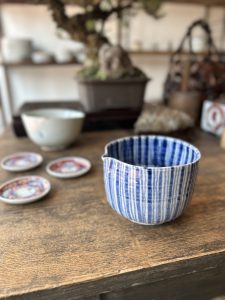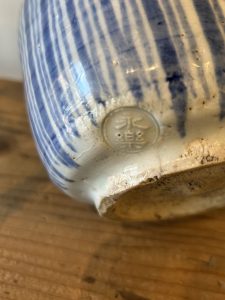十草模様のおおらかさ(愛知県名古屋市千種区姫池通 骨董買取 古美術風光舎)
2025.03.22
春の陽気に誘われてお出かけされている方も多いのではないでしょうか。上着を脱いで手に持っている方も多く見かけ、私も少し歩いただけでじんわりと汗をかきました。あと数ヶ月でやってくる猛暑に備え体に予行練習をさせる良い季節かもしれませんね。
さて風光舎に新しく仲間入りしました、永楽の器。小さな片口が可愛く、様々な用途に使えそうです。上部半分には横に波打つように溝があり手に馴染みやすく、また青い縦縞がゆらゆらと揺れているようにも見え美しいです。
ただ凹凸の上をフリーハンドで真っすぐ線を描くのは難しそうですよね。頭の中でシュミレーションしてみましたが、元々絵が不得意なこともあり、絶対に無理だな…と確信しました。

外と内に描かれている青い縦縞模様は古くから日本で親しまれてきた模様のひとつで、「十草(とくさ)」とよばれているそうです。植物のトクサがモチーフとなっており、日本では中部地方より北に分布し湿地や岸辺などに自生しているシダ植物です。写真を見ますと「つくし」のように節があり、草というより茎が林立しているような不思議なイメージです。この固くザラザラした茎を木材や爪などを磨くのに使ったことから「砥石になる草」→「砥草」と書かれることもあるようです。固い茎で歯を磨くこともあったようで、「はみがき草」という別名もあるとか。
このトクサの真っすぐに伸びる姿をモチーフとした十草模様は、成長や繁栄の象徴として江戸時代から愛されてきました。また金を磨く時にトクサの葉で磨くと光沢が出ることから「金を呼ぶ」ともいわれ、いずれにしても縁起の良い模様です。
十草模様には綺麗に1本線がひかれているものから、線に強弱があるもの、太さに変化をつけたものなど様々あるそうで、シンプルだからこそ自由度が高いデザインなのでしょうね。
京都で茶道具を中心に制作する作陶の名門、永楽家。その歴史は室町時代にまでさかのぼります。祖先は奈良、春日大社の斎器をつくる家柄だったといわれ、宗禅を祖とし、11代目保全までは西村姓を名乗っていました。9代目までは茶の湯に用いる土風炉の製作を生業としていましたが、10代目以降は土風炉だけではなく茶陶の分野も手掛けるようになったとのこと。染付、色絵、交趾焼など多種多様で華やかな作風のものが多いとされています。
現在は17代目永楽善五郎氏が引き継いでいらっしゃいます。
この機会に京焼とはと調べてみますと、思った以上に複雑で私ごときには理解が難しく、分かったような、分からないような感覚だけが残りました。京都の様々な窯元がお互いに切磋琢磨し独自の逸品を生み出してきたということでいいでしょうか。ある方が「京焼とは京都のやきものが他の産地や国のものと競う時に使われるもの」と仰っていて、そういう考え方もあるのかと膝を打ちました。
それで納得するだけでなく、もう少しお勉強も必要かと思われます。

それでは、また次の機会に。(スタッフH)
※この度、古美術風光舎では《うつわと骨董展》を店舗にて開催いたします。
《うつわと骨董展》
4月5日(土) 10:00~17:00 開催
4月6日(日) 10:00~17:00 開催
また、4月12,13日は覚王山春祭りも開催されており、春の覚王山界隈はとても賑やかに華やいでおります。風光舎も皆さまのご来店を楽しみにお待ち申しあげておりますので、お気軽にお立ち寄りください。
I am sure many of you are out and about in the spring weather. I saw many people taking off their jackets and holding them in their hands, and I was sweating just by walking a little. This may be a good time to prepare your body for the heat wave that will be coming in a few months.
Now, Eiraku vessels are new additions to the Fuhkosha. It has a cute little one-sided mouth and can be used for a variety of purposes. The top half of the bowl has a horizontal groove that makes it comfortable in the hand, and the blue vertical stripes look as if they are swaying, which is beautiful.
It seems difficult to draw straight lines freehand on the uneven surfaces, doesn’t it? I tried to simulate it in my mind, but I am not good at drawing, and I was convinced that it would be absolutely impossible….
The blue vertical stripe pattern on the outside and inside of the handles is one of the Japanese traditional patterns and is called “Tokusa” (ten grasses). The motif is based on the plant “tokusa,” which is a fern that is found in Japan north of the Chubu region and grows wild in wetlands and along banks. The photo shows that it has knots like “Tsukushi,” giving it a strange image of a forest of stems rather than grass. The hard, rough stems were used to polish wood, nails, and other objects, hence the name “whetstone grass. The hard stems were also used to brush teeth, and it is also known as “hakimigusa.
The ten-weed pattern, based on the straight growth of the tokusa, has been a symbol of growth and prosperity since the Edo period (1603-1868). It is also said to “bring in gold” because of the luster produced when gold is polished with the leaves of the tokusa plant.
There are various types of jyukusa patterns, including those with a single clean line, those with strong and weak lines, and those with varying thicknesses, etc. The simplicity of the design allows for a high degree of freedom.
The Eiraku family is a prestigious pottery family in Kyoto that mainly produces tea ceremony utensils. Its history dates back to the Muromachi period (1333-1573). The Eiraku family is said to have been the ancestors of the family that produced the saibi for Kasuga Taisha Shrine in Nara, and the family name was Nishimura until the 11th generation, when it was succeeded by Sozen. Many of his works are said to be diverse and gorgeous in style, such as tsuchitsuke (underglaze blue), iroe (overglaze blue), and koji-yaki (togi-yaki).
Currently, Eiraku Zengoro, the 17th generation, is taking over the pottery.
When I took this opportunity to look into Kyoyaki, I found it to be more complicated than I had expected and difficult for me to understand, leaving me with a feeling of both understanding and not understanding. I guess it can be said that various kilns in Kyoto have created their own unique masterpieces through friendly competition with each other. One person said, “Kyo-yaki is used when Kyoto pottery competes with pottery from other regions or countries,” and I was struck by this idea.
I was struck by this idea. I think I need to study a little more than just agreeing with him.
I will see you next time. (Staff H)
We are pleased to announce that we will hold the “Utsuwa to Kotto Exhibition” at our store.
The exhibition will be held on April 5 (Sat.).
April 5 (Sat) 10:00-17:00
Sunday, April 6, 10:00-17:00
The Kakuozan Spring Festival will be held on April 12 and 13, and the Kakuozan area will be very lively and colorful in spring. Fumikosha is looking forward to seeing you at our store, so please feel free to stop by.
*****************
ご実家の整理やお片付けなどをされている方のご相談などが多くございます。
お片付けなどくれぐれもご無理のないようになさってくださいませ。
風光舎では古美術品や骨董品の他にも絵画や宝石、趣味のお品など様々なジャンルのものを買受しております。
お片付けをされていて、こういうものでもいいのかしらと迷われているものでも、どうぞお気軽にご相談下さいませ。
また風光舎は、出張買取も強化しております。ご近所はもちろん、愛知県内、岐阜県、三重県その他の県へも出張いたします。
まずは、お電話お待ちしております。
なお、毎月21日の持込鑑定会では無料鑑定・買取・持込など、ご予約なしで承っております。
ご近所の皆さま、ご遠方のみなさまも、お気軽にお越しくださいませ。
愛知県名古屋市千種区姫池通
骨董 買取【古美術 風光舎 名古屋店】
TEL052(734)8444
10:00-18:00 OPEN
#出張買取#骨董#古美術#骨董品#絵画#版画#茶道具#刀剣#彫刻

